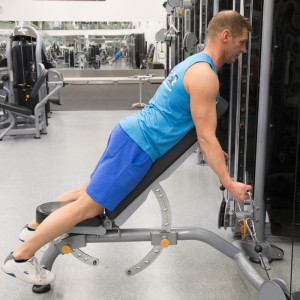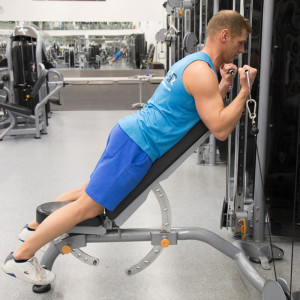Cable Incline Curl
Starting position:
- Grasp the D-handles attached to each side of the low pulleys of the cable crossover station with a closed, supinated grip (palm facing upward).
- Lie face-up on an incline bench placed directly in between both pulleys with arms extended at your sides, keeping a slight bend in elbows and palms facing upward.
- Place both feet flat on the floor.
Upward movement/concentric phase:
- Simultaneously flex both biceps, bringing both D-handles towards your shoulders as elbows flex.
Downward movement/eccentric phase:
- In a controlled fashion, allow the elbows to extend back to the starting position, keeping arms elevated.
- Once you have returned back to starting position, keep a slight bend in the elbows (maintaining tension on the biceps) before performing the next repetition.
Exercise Data
FAQ'S & FACTS ABOUT Cable Incline Curl
What Is A Biceps Cable Incline Curl?
An incline cable curl is a resistance exercise, which involves the primary elbow flexors, the brachialis and biceps brachii. This exercise requires a cable crossover station with low pulleys at each side and two D-handles. The exercise is performed lying face-up on an incline bench in between both pulleys at a cable crossover station. The incline cable curl is a variation of biceps exercises in which the biceps contract with arms out to the side, as opposed to arms facing forward as with most traditional biceps exercises. Performing curls with cable tension provides constant resistance throughout the entire range of motion.
The concentric portion of the lift is elbow flexion, which involves the lifting of the weight. The eccentric portion is elbow extension, which involves the descent of the weight.
The purpose of the incline cable curl is to strengthen the biceps while promoting hypertrophy (increases in size) of the biceps.
Why Do Biceps Cable Incline Curls?
Incline cable curls strengthen and increase the size of the biceps brachii and brachialis from a different angle. The position of this exercise is unique to other biceps exercises in which the arms are out to the sides and curling in a different direction. Performing elbow flexion against resistance in this position of the arms creates a varied stress and tension on the biceps muscle fibers. Activating the biceps brachii at different angles can optimize hypertrophy of the biceps, placing a new stress for the muscles to adapt to. Incorporating incline cable curls into a well-strategized exercise regimen can help increase force production and size of the biceps brachii.
Although it is primarily an exercise for aesthetics, incline cable curls also serve as an auxiliary exercise that can increase strength involved in other multi-joint exercises.
Anatomy Of A Biceps Cable Incline Curl
The biceps brachii is located on the front of the arm, originating at the shoulder and inserting in the elbow joint. It consists of two heads, the long head (outer portion) and the short head (inner portion). The long head tendon helps stabilize the shoulder joint and its origin is located at the tubercle and lip of the glenoid cavity of the scapula (shoulder blade). The short head origin is located at the coracoid process of the scapula. The long and short head unite as the muscle bellies run down the front of the arm. Both heads merge, sharing insertion into the radial tuberosity of the elbow joint.
The biceps brachii flexes the elbow joint and supinates the forearm. Supination refers to the simultaneous rotation of the wrist and elbow as the palm of your hand faces upward.
The brachialis lies underneath the biceps brachii, originating at the front of the lower end of the humerus bone. Its insertion is located at the coronoid process of the ulna at the elbow joint. The brachialis is a primary elbow flexor.
The brachioradialis aids the biceps brachii and brachialis in the standing biceps curl, helping stabilize the elbow joint.
Primary forearms flexors, flexor carpi radialis and flexor carpi ulnaris are stabilizers. Both insert at the elbow joint and attach at the metacarpals near the wrist.
Variations Of A Biceps Cable Incline Curl
High pulley cable curl.
How To Improve Your Biceps Cable Incline Curl
Focus on the concentric portion of the contraction, concentrating on “squeezing” at the end of the flexing portion.
Emphasis on eccentric contractions, prolonging the eccentric portion of the contraction, may also be incorporated in a training program focused on increasing strength. This should be implemented accordingly and with adequate muscle recovery as eccentric contractions cause substantial damage to muscle tissue.
It’s important to note that your repetition and set volume will depend on your goals (e.g. strength, hypertrophy, muscular endurance). This exercise, typically, is done with relatively lighter weight as the biceps are isolated and cheating/body momentum is not possible.
It is also important to allow adequate recovery days in between biceps training to allow muscles to repair.
Common Mistakes When Doing Biceps Cable Incline Curls
Returning the weight to starting position too quickly. Performing the eccentric portion of the lift ballistically (e.g. extending the elbows quickly, allowing the weight to drop) and/or hyperextending the elbows can result in biceps tendon and/or shoulder injuries.
Injuries Or Ailments & Their Effects Regarding Biceps Cable Incline Curls
If proper technique is not adhered to (e.g. dropping the weight quickly instead of controlling the descent on the eccentric portion of the lift), the likelihood of a biceps injury increases.
Although rare, biceps tendon rupture may occur if warm-up is not sufficient and/or if intensity (load) is increased inappropriately.
If proper recovery is not implemented between training days for optimal muscle repair of the biceps, the biceps tendon becomes inflamed. Without proper rest and treatment, the inflammation remains and results in biceps tendonitis.
Impingement syndrome and rotator cuff injuries, in general, are commonly associated with biceps tendonitis/biceps tendinosis. Therefore, it’s best to avoid bicep exercises when addressing impingement syndrome/rotator cuff injury unless advised by a physical therapist.





